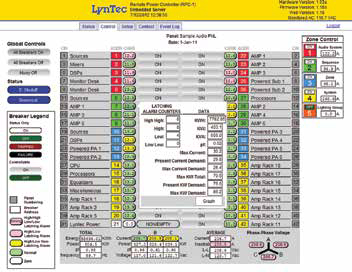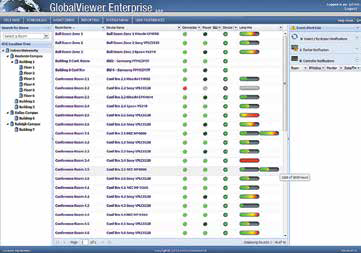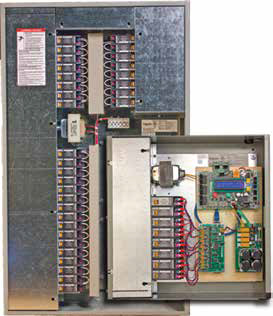Your Energy Report Card

How much money are tech managers wasting on energy from AV and IT systems?
The next time you have some time to spare, take a walk through your building. Count the number of rooms with lights and projectors on, but empty of teachers or students. Chances are that the number of unused but lit rooms will be high.
With each uninhabited room wasting as much as five kilowatts of power, it’s a lot of electricity and money that could go to other, more worthwhile, purposes. Despite a lot of progress making electrical equipment of all types more energy-efficient, schools still waste as much as 30-percent of the power they use, according to a recent survey by the Environmental Protection Agency.
The monthly electricity bill can eat a significant hole in any school’s budget, with the EPA estimating that nationwide K-12 schools alone have power bills reaching $6 billion per year. That’s more than they spend on computers and textbooks combined.
While there are exceptions, the energy report card for the typical school might read something like this:
Grade: D
The school hasn’t shown enough progress in lowering its overall energy use and continues to ignore opportunities to save lots of energy. It needs to progress in developing the ability to stop wasting power in lighting, AV gear and climate control.
Overall: The school needs to show a lot of improvement for the next grading period.

Crestron’s Fusion lets tech managers compare any month, week, or day’s data to run through what if scenarios aimed at lower energy use. This can include anything from automatically turning all classroom lights off at 6PM to rescheduling an afternoon’s classes to one part of the school so that the rest can be partially shut down. It can even track the school’s carbon footprint. It's time to reframe and rethink this topic. There are dozens of schools that have solar panels and keep wasted electricity to a minimum, but, sadly, they are the exception. The majority of schools still need remedial attention when it comes to how they view and use energy.
A daily selection of features, industry news, and analysis for tech managers. Sign up below.
Regardless of whether it’s an elementary, middle-, high-school, or college, there are so many schools that are not making the grade when it comes to saving power. Improving isn’t hard because there’s so much low hanging power fruit that range from replacing old lighting fixtures with modern LEDs to replacing old ventilation fans with newer, more efficient ones (see our sidebar: “Tips for the Power Parsimonious”). It’s just the tip of the iceberg, with a slew of automated ways to make every electron count.
“No doubt, schools can be big power wasters,” said Mark Bishop, president of LynTec, a Lenaxa, KS, company that specializes in computer-controlled power equipment. “They generally don’t invest in ways to save electricity in existing buildings that could be paid back fairly quickly.”
A sure path to better energy management is to go from ignoring power use to re-engineer the school as a smart building. The key is the ability to monitor and remotely control as many energy users on campus as possible. This includes lights, heating and ventilation as well as all audio-visual gear, like classroom projectors. The idea is not to cut off the power when it’s needed, just when there’s no teaching going on.

AMX’s Resource Management Suite monitors, manages and controls where power goes in a building. It can aggregate different types of energy consumers for groups, like projectors, lights and climate control. These show up in a colored pie chart, making it easy to see at a glance if one area is becoming a power hog. That’s exactly the idea behind version 3.3 of AMX’s Resource Management Suite. The software monitors, manages and controls where power goes in a building and can aggregate different types of energy consumers for groups, like projectors, lights and climate control. These show up in a colored pie chart, making it easy to see at a glance if one area is becoming a power hog.
“The system can monitor all the equipment in a room,” said Casey Foulds, Education Customer Relationship Manager at AMX’s Richardson, TX, headquarters. “That way, it’s ready when needed but everything can be turned off when it’s not in use or at the end of the day.”
For instance, the Texas Woman’s University’s Denton campus used the AMX hardware and software to make sure that any projector left on at the end of the day would automatically be turned off at 11PM. Not only did the TWU’s power use go down, but the school, which has nearly 13,000 students at its Denton campus, saved $70,000 in projector lamps.
The AMX sensors and software are smart enough to respond to out of the ordinary situations. For instance, if a room gets too hot or a computer is stuck in a rebooting cycle and never gets to its idle power use, the system can send a text message or email to alert an IT or facilities staffer.
A big step forward is that the AMX software has dashboard Widgets that chart power consumption, putting the actual amounts in your face where it’s hard to ignore. It can even put together a carbon footprint based on the school power use.

A GUI (graphical user interface) from LynTec By contrast, Extron’s GlobalViewer Enterprise (GVE) can see what equipment and lights are turned on in a browser window that can be viewed on anything from a smartphone to a desktop PC. The hierarchical tree layout shows a room-by-room rundown of the school, indicating which have lights and AV gear powered up and which don’t.
“Having this kind of information empowers people to make choices about power use,” explained Joe da Silva, Director of Product Marketing at Anaheim, CA-based Extron Electronics.
The Extron software not only doesn’t require having a resident programmer to make changes, but the next generation, GVE 2.2, of the software will be able to link with infrastructure using BACnet and KNX software; the update is expected this summer. This opens up the ability to link GVE with systems controlling access, climate control and lighting on a room by room basis.
“It can control anything from remotely locking doors at the end of the day to turning the thermostat down at 10PM for the night,” added Extron’s da Silva.
Power Hungry

The motorized circuit breakers are controlled by LynTec software, which monitors how much power each circuit is drawing and shows it in a browser window. This allows the LynTec system to be used with just about any connected computer, including Macs, PCs, iPads, and Android systems. Crestron’s Fusion EM power management software displays where every watt is going and can turn any facilities manager into a power scrooge by individually shutting off unnecessary items from anywhere on the network. The software lets you remotely kill the lights, lower or raise powered window shades as well as lower or raise the room’s thermostat for cooling and heating. You can even shut off a projector that was inadvertently left on after the class scattered at the bell.
There’s a big pay-off to the Fusion EM software because it can broadcast an emergency message to projectors, monitors and Crestron touch-screen control panels. This can be useful for announcing a fire drill or telling everyone to shelter in place during a criminal incident.
While the software can drill down to each power-user it controls, Fusion totals up the school’s (or district’s) total power use, making it a good way to compare different power strategies, try out new scenarios and develop a comprehensive energy-saving strategy.
Using Fusion’s interface, the software lets managers compare any month, week or day’s data to run through what if scenarios aimed at lower energy use. This can include anything from automatically turning all classroom lights off at 6PM to rescheduling an afternoon’s classes to one part of the school so that the rest can be partially shut down. It can even track the school’s carbon footprint.
Slaying the School Vampires
One place to make a big impact on a school’s power budget is in reducing phantom or vampire power. Just about every device — from projectors to tablets — draws a small amount of power even when it’s off or fully charged.
“Each device on its own isn’t all that much of a problem,” added Bishop. “But, a whole building’s worth adds up to a lot of wasted power.” LynTec uses motorized circuit breakers made by Square D to provide individual circuit control over power use.
The motorized breakers cost more than standard mechanical ones, but can save a lot of power and money by automatically switching themselves off. Because so much electricity is saved, the pay-back period for the investment is rapid. “It generally pays for itself in about a year,” concluded Bishop.
Still, getting an existing school to install controllable power equipment is a hard sell most of the time. “The savings in power costs is so great that for new school construction, it’s a no brainer,” added LynTec’s Bishop. “For retrofitting older schools it’s still a tough sell to find the money to do the work.”

Extron’s GlobalViewer Enterprise (GVE) can see what equipment and lights are turned on in a browser window that can be viewed on anything from a smartphone to a desktop PC. The hierarchical tree layout shows a room-by-room rundown of the school, indicating which have lights and AV gear powered up and which don’t. The motorized circuit breakers are controlled by LynTec software, which monitors how much power each circuit is drawing and shows it in a browser window. This allows the LynTec system to be used with just about any connected computer, including Macs, PCs, iPads, and Android systems.
The system not only protects the school’s sensitive computer equipment from brown-outs that occur when the electricity feed’s voltage falls below about 95-volts, but based on a preset power scheme, those power-consumers not in use are shut down when nobody’s around. Sound like the beginning of a bad late-night horror movie about a group of kids stuck in a dark school with a mad janitor on the loose? The LynTec system is smart enough to be overridden by an occupancy sensor.
The George Washington Carver High School in New Orleans’ Ninth Ward, which was destroyed in Hurricane Katrina, was recently rebuilt from scratch. Engineered to the U.S. Green Building Council’s Silver level, the 227,000-square-foot facility will not only minimize the amount of artificial light needed with large classroom windows, but uses LynTec’s power equipment to sense and reduce power load.
A big step forward for schools is that no longer are you restricted to using one vendor’s power control equipment and software. They are compatible with each other and buyers can now pick and choose among AMX, Extron, Crestron, and LynTec to use the best of breed equipment to mix and match to cut their operating expenses.

The LynTec system is smart enough to be overridden by an occupancy sensor. At the end of the school day, power awareness is aimed at cutting costs, but it has an ecological aspect as well. That’s because every kilowatt-hour of electricity saved equals roughly 1.6-pounds of carbon not spewed into the atmosphere by a coal-fired power plant. That makes it one of the greenest thing that a school can do.
Margot Douaihy is the Editorial Director of EDUwire and AV Technology.
Tips for the Power Parsimonious
1 Go ahead: become Power Mad, making students and teachers mindful that leaving lights or AV gear on is wasteful and bad for the environment. Consider having a chief power officer who conducts audits of the monthly power bills, looks for savings in everyday items and sets goals for annual power reduction.
2 Get rid of inefficient incandescent and older fluorescent lights and replace them with super-efficient LED-based lighting. That goes for everything from individual library reading lights to the huge gym lights. You’ll find that the savings can be as high as 80-percent and they will likely never need to be replaced.
3 Maintain the school’s heat and cooling infrastructure so that it is an efficient energy user. Simple things like replacing old fan motors and periodically checking filters can have a big impact.
4 Be as green as you can. Consider bolstering the school’s power sources with renewables, like solar panels or wind turbines. The beauty of these sources is that they have a zero carbon footprint and the school can sell power to the grid during the summer when the facilities aren’t being used.
5 Regardless of whether they’re in a computer lab or the school’s office, replace desktops with notebooks that use about one-quarter the power. Always set the computers to dim the screen after 15 minutes of inactivity and go to sleep after 20 minutes so they don’t consume too much power when not being used.
6 Identify power hogs, like an old refrigerator in the cafeteria or antiquated parking lot lighting. New equipment will save enough electricity to pay for itself in 12- to 18-months. After that, it’s gravy.
Margot Douaihy, Ph.D., is a lecturer at Franklin Pierce University.

